LINKING THE COASTAL AHU PLATFORMS BY CODED DISTANCES AND ANGLES
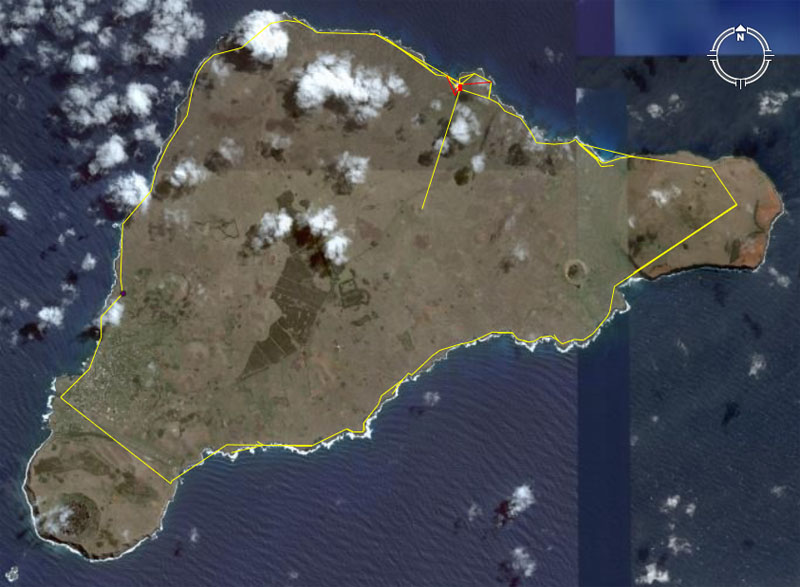
Due to the high resolution imagery provided by Google Earth, one can hover a few hundred feet above any part of the island and see most of its ground features. By going around the coastline and observing carefully, the many ahu platforms on the perimeter can be seen with relative ease. The very accurate measuring tool provided by Google Earth then allows one to measure the separating distances between ahus. To accurately determine angles, measuring lines established in Google Earth are transferred to AutoCAD for precise reading. The above picture shows continuous, connected straight lines running from the central sections of each ahu to the next neighbouring ahu up or down the coastline. Every individual line seen including offshoots to positions slightly inland, is a specific, coded length and angle. These same lengths and angles were encoded into the geometry of the Nazca Desert in Peru; the Octagon geometric embankments of Newark, Ohio, USA; Avebury Henge in Southern England and throughout the Gizeh Plateau of Egypt. They are simply the "ages-old" ground marked encoding of the ancient navigational and astronomical cyclic sciences by way of a specific distance and angle off north. The same values recur constantly in the weights, measures & volumes standards of the ancient Mediterranean and Europe. When a civilisation does not have access to vast quantities of perishable paper in order to record their scientific knowledge in books, it can be eternally preserved in the positions of durable ground markers.
The ancient designers of the Easter Island school of navigation built "open air classrooms" all the way around the island. These came in the form of ahu platforms, with placed moai statues or other types of markers either on the platform or standing some distance away at carefully coded distances and angles. The student navigators would walk around the coast, stopping and learning the special knowledge offered at each new "classroom". To complete their lessons, they needed measuring instruments and rules, a way to determine true north and calculation or abacus devices. Let's begin at the most major "classroom" on the northern part of the coast (Ahu Nau Nau at Anakena Beach, restored by Thor Heyerdahl and his team) and link in the related ahu platforms that branch off this main one.
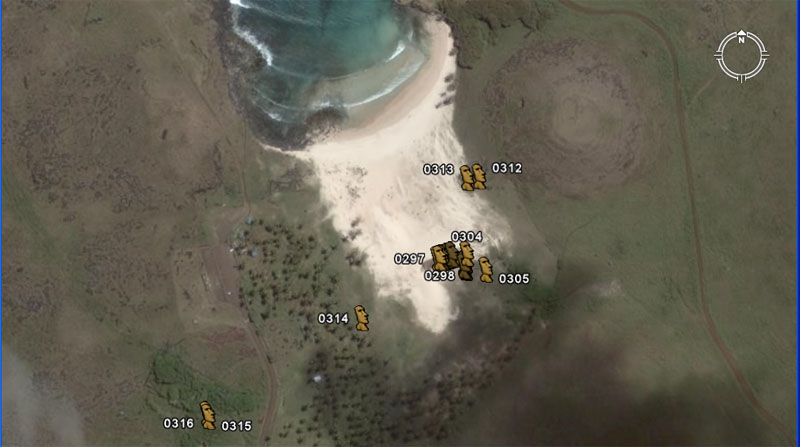
The Anakena Beach archaeological sites, as shown within the Rapa Nui Archaeological Database at California State University, Long Beach, California, USA. They have, very graciously, made high resolution photos available of each of these markers for public scrutiny and research analysis. Their website is truly amazing and the surveying data provided (coordinate positions of moai), astounding. It is now possible to do precise distance and angle measurements between the carefully placed markers and identify the original tutorials put in place for students of navigation.
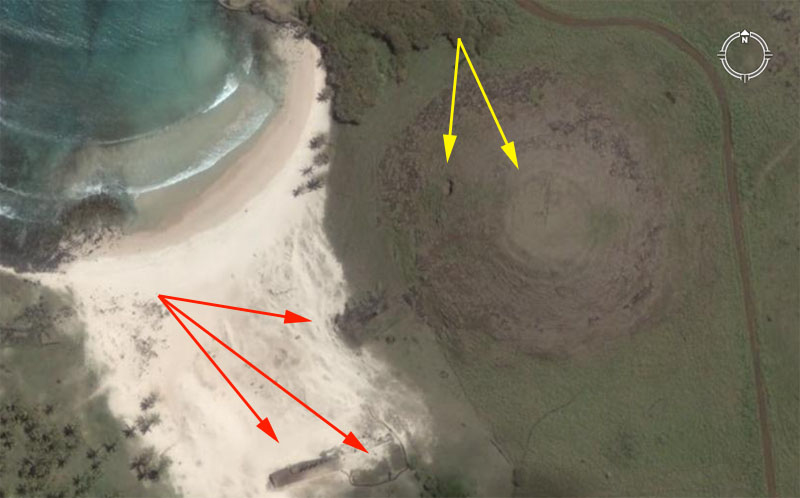
The red arrows show the locations of ahu platforms at Anakena beach, including the very impressive Ahu Nau Nau . In this case the moai statues and other kinds of markers are the "outer markers" that relate by distance and angle to the two positions shown by yellow arrows. The primary "benchmark" or surveying hub position for this northeastern location is the cut cleft excavation in the side of the purpose-shaped and modified volcanic cone. All of the nearby moai or surveying positions and ahu platforms in the near vicinity, or for up to 1.8-miles up the coastline, relate back to these two positions and especially to the benchmark cleft in the side of the hill.
Let's demonstrate the surveying principles that were encoded into the Anakena Beach hill position by ancient navigator-astronomers:
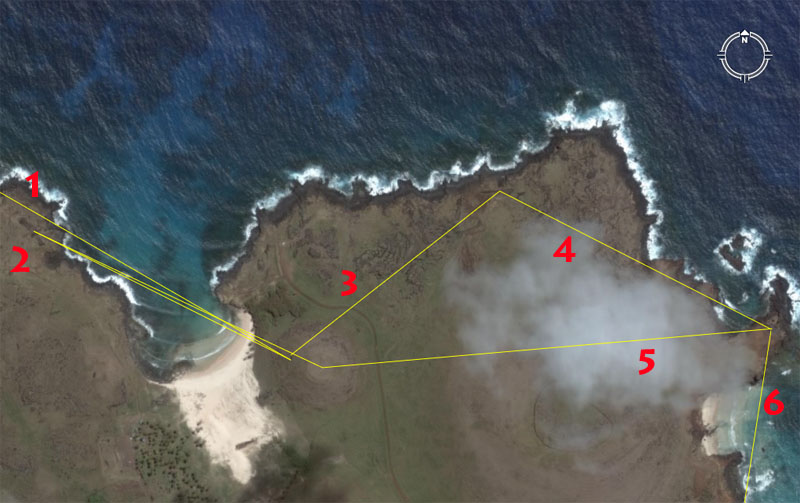
Here are the first of a series of coded survey lines and angles that run from the two hill positions to other ahu platforms or surveying mark positions:
1. This line runs from the western wall of the benchmark cleft in the side of the hill for exactly 1.8-miles @ precisely 300-degrees azimuth to resolve upon the centre of an ahu platform on the northern coastline. The elevated position of the benchmark cleft, in the side of the hill, should have made many outer target positions visually accessible. It was placed high for this very reason. The fact that the northern target sits at exactly 300-degrees would have allowed for correct setting of manual theodolites or calibrated compass disks to read the precise azimuth positions of all other surrounding targets.
2. From the benchmark cleft a line runs northwest for 1680-feet @ 116.64-degrees (116.6666) to resolve upon the centre of a nearby wrecked ahu platform. The fact that the precise distance of 1680-feet has been chosen is a very strong clue that a 3,4,5 triangle had been built into the surveying geometry of the immediate region (this will be explained as we proceed). The value 168 was highly important to ancient navigation and a mathematical progression based upon this value produces most of the very important values related to the Great Pyramid's geodetic system for the equatorial size of the Earth. The most commonly used rendition of PI anciently was 22/7ths. A circle of 1-mile (5280-feet) ÷ 22/7ths = 1680-feet.
The angle of 116.64-degrees (or 116.6666 ... 116 & 2/3rds) is in homage to the Roman lunar foot of 11.664-inches or overland foot of 11.6666-inches. In ancient Egyptian capacities, a Theban was 11664 cubic inches, whereas a Beshu was 1166.4 cubic inches and a Honnu was 116.64 cubic inches. Under the Great Pyramid's Earth geodetic standard, the sum of 11664-feet would be 1/11200th of the equatorial size of the Earth.
2A. From the nearby wrecked ahu centre, a line runs back to the hill at Anakena Beach, but this time bypasses the benchmark cleft in the side of the hill and resolves to the epicentre of the top. The distance was undoubtedly set to represent 1886.24-feet, at a return azimuth angle of 295.3125-degrees (as shown). The 1866.24-feet code is in homage to the equatorial size of the Earth and 1866.24-feet would be 1/70000th of the equatorial circumference under the Great Pyramid's geodetic assignment. The value recurs in ancient Mediterranean measures and under the Jerusalem standard for liquid volumes a "Cor" was 18662.4 cubic inches, whereas a"Bath" was 1866.24 cubic inches. The same holds true for the ancient Syrians who had a "Maris" that was 1866.24 cubic inches. Similarly, the Roman liquid "Congius" was 186.624 cubic inches. The value of 18662.4 is 3/4ths of 24883.2 (the number used to describe the equatorial circumference of the Earth). The Babylonian-Sumerian "Double Royal Talent" weight was 93312-grains (half of 186624), etc.
The degree angle of 295.3125 (295 & 5/16ths) is in homage to the lunar month of 29.53125-days (to a precision of under a minute). The Khafre Pyramid @ 708.75-feet length per side is 29.53125-feet (29 & 17/32nds) X 24.
3. This line runs from the eastern wall of the benchmark cleft for an intended coded distance of 1555.2-feet @ 51.84-degrees to resolve to the centre of a wrecked ahu platform. The distance of 1555.2-feet is in homage to the 24883.2-mile equatorial circumference of the Earth, of which a distance of 1555.2-miles would be 1/16th. The value recurs in ancient weights & volumes of the Mediterranean and under the Hebrew Desert Liquid volumes standard a "Bath" was 1555.2 cubic inches. Similarly a Greek Medimnus volume was 3110.4-cubic inches (2 X 1555.2).
The angle of 51.84-degrees is the slope angle of the Great Pyramid. It's the azimuth angle that the Octagon earthmound embankment complex lies on through its entire length. The base area occupied by the Great Pyramid is 5184 square reeds (72 X 72). In the 25920-year cycle of Precession, 51.84-years is 1/500th part. The linear distance of 1-British league (3.125-miles or 16500-feet) converts to a circumference of 51840-feet using the navigational rendition of PI (for "11" family numbers) of 3.141818182.
4. From this second wrecked ahu platform, the line turns south and runs for 1782-feet to a rock promontory fix point on a jutting peninsula. The azimuth angle is 297-degrees, which is a part of the same navigational mathematical progression as 1782.
5. From the centre of the hill to the same promontory point in the natural landscape, the distance is very close to 2640-feet or half a mile and the azimuth angle could easily be interpreted as 85.05-degrees (a dynamic lunar code). A mathematical progression based upon 85.05 produces the essential numbers used in calculations within the lunisolar Sabbatical Calendar, including 2551.5-days (7.2-lunar years) and 6804-days (the duration of the lunar nutation cycle), etc.
6. From the promontory, a line runs inland southward for 1584-feet (navigational code) at a return angle of 8.75-degrees (calendar code) to alight upon an ahu platform. The Earth was anciently considered to be 7920-miles wide (24883.2 ÷ PI @ 3.141818182) and the sum of 1584-miles would be 1/5th of that value.
Under the Sabbatical Calendar system (used in peasant or agrarian communities) the calendar was allowed to run for 7-solar years without interruption. Under this system each week was 7-days long; each month was 28-days and there were 13-months per annum (364-days). At the end of the 7th or Sabbatical Year, a festival was held to correct the calendar and 8.75-days (9-days) were used up. The calendar count then recommenced fully corrected. Ancient astronomer-mathematicians used more sophisticated systems to monitor the daily lunar and solar positions or cycles.
THE IN-DEPTH NAVIGATIONAL AND ASTRONOMICAL TUTORIALS OFFERED AT ANAKENA BEACH.
The terrain across Easter Island can be quite rough and rocky in places and the undulating ground does not always afford the viewer uninterrupted panoramic views across the totality of the island. The "classrooms" around the coastline were built to exploit what was locally available in the topography, geology and vistas at each station. Anakena Beach had its own set of advantages and disadvantages, but was well situated and suited to offer the student navigator some very profound information. Let's see how many of the old tutorials are still retrievable in the surrounding landscape and tumbled moai positions.
In this probe, we'll test several hubstone positions and identify what potential coded distance and angle information reposes in each. Let's begin by sending out lines from the benchmark cleft on the side of the Anakena Beach Hill. In this exercise we'll be able to work directly from Google Earth imagery, as the positions of the ahu platforms and their moai can be detected therein. The amount of photographic distortion encountered when working between differing elevations should be minimal, as the fluctuations in height are reasonably small.
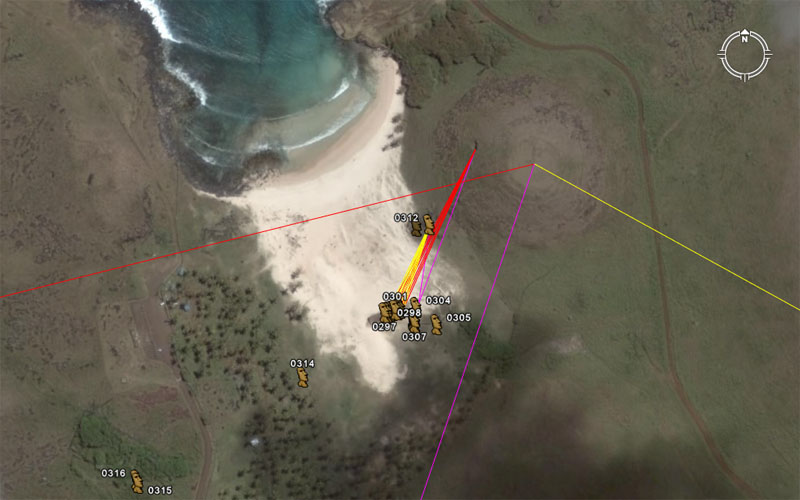
Because the main moai positions on Anakena Beach can be visually detected in Google Earth, we will eliminate the moai figurines from the Rapa Nui Archaeological Database that appear in the above picture as we undertake a study of local positional codes. Also although there are a multitude of highly significant alignment codes originating on the top plateau of Anakena Beach hill (Easter Island's version of Silbury Hill in Southern England) and extending to such places as Maunga Terevaka, Rano Kau volcano, Puakatike volcano at Poike and elsewhere, for visual simplicity we'll only touch on a few of them at the moment. Here are some of the major alignment codes:
1. The red line disappearing off the picture to the left, runs to Maunga Terevaka (the highest point of the island). The distance is coded to be 19800-feet and the azimuth angle is 256-degrees. As explained, the 19800-feet value is in homage to the width of the Earth at the equator, which is 7920-miles (1980 X 4). The angle of 256-degrees is navigational also and a mathematical progression based upon 256 produces dynamic values used in navigational calculations.
2. The magenta line running to the bottom of the picture
resolves 12441.6-feet away at the high point of Maunga (Mount) Puhi in the
central zone of the island. The angle to that point is coded to be 18.6624-degrees,
which highly refined degree angle would have been rounded to 18.66666-degrees
(18 & 2/3rds). Nevertheless, the student of navigation would have been
obliged to memorise the 186624 value. It was used copiously in the weights
and measures of the ancient Mediterranean*. The distance is coding half the
equatorial circumference of the Earth (24883.2 ÷ 2 = 12441.6). The
angle is also coding the equatorial circumference. The sum of 186624-feet
would be 1/700th of the distance around the Earth.
*(Note:
The Jerusalem Standard "Cor" was 18662.4 cubic inches and the "Bath"
was 1866.24 cubic inches; the Roman liquid "Congius" was 186.624
cubic inches and the Syrian "Maris" was 1866.24 cubic inches.
3. Although it's not seen in this picture, the magenta line, where it touches the peak position of Mount Puhi, turns to run due east to the resolving plateau of Puakatike volcano at Poike. The distance is 25200-feet, which equates to 24000 Greek feet or 12000 Assyrian cubits. The same distance is 2400 Hebrew Reeds, etc. This distance is 1/5184th of the equatorial circumference. Note: The base of the Great Pyramid covers 5184 square Reeds of 10.5-feet each. The slope angle of the Great Pyramid is 51.84-degrees, etc. The value is one of the most dynamic of antiquity. This true east-west line running centrally through a large part of the island provided an important surveyor's baseline for triangulation computations.
4. The yellow line in the picture above runs for 24300-feet at an azimuth angle of 118.8-degrees to the resolving platform atop Puakatike volcano at Poike. The 24300-feet distance carries both strong lunar and navigational coding simultaneously. In the 6804-day lunar nutation cycle there are 28-periods of 243-days. The lunisolar Calendar of Coligny bronze plaque of Druidic France is 4.86-feet long (2.43 X 2). The Roman (lunar) Mile (5000 Roman feet of 11.664-inches each) = 4860-feet of 12-inches (2 X 2430), etc. The angle of 118.8 is navigational. Under the Great Pyramid's second reading of an equatorial circumference of 24750-miles, the sum of 11880-feet would be 1/11000th part.
ANAKENA HILL'S BENCHMARK CLEFT.
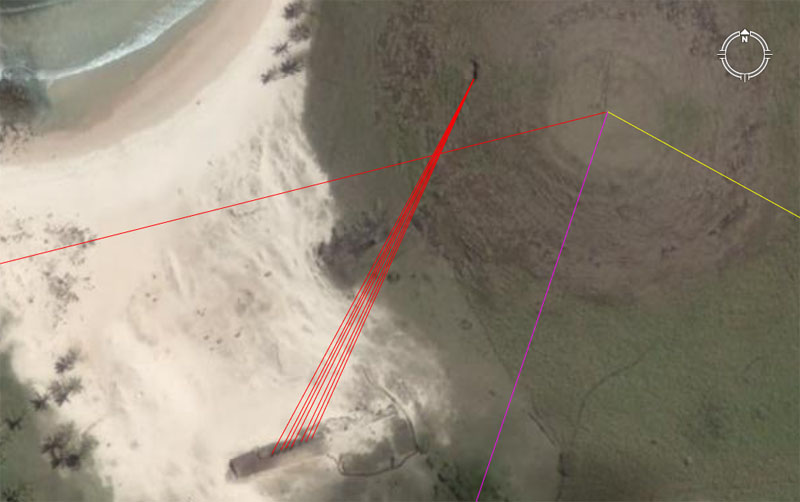
At Anakena Beach hill there is a carefully chosen surveying benchmark position cut into the WNW side of the hill and it determines the positions of the moai on the ahu platforms below. Here are some of the apparent codes of distance and angle to this elevated position (moving along Ahu Nau Nau platform from left to right), statue by statue.
1. 560-feet @ an azimuth angle of 28.35-degrees (moai to cleft).
2. 550-feet @ an azimuth angle of 27.5-degrees (moai to cleft).
3. 544.32-feet @ an azimuth angle of 27-degrees (moai to cleft).
4. 540-feet @ an azimuth angle of 26.4-degrees (moai to cleft).
5. 528-feet @ an azimuth angle of 25.515-degrees (moai to cleft).
6. 525-feet @ an azimuth angle of 24.8832-degrees (moai to cleft).
7. 518.4-feet @ an azimuth angle of 24.3-degrees (moai to cleft).
Each of the above values is highly important to the ancient systems of navigation or reading the lunar cycles, etc., and constituted high science needful if a nation was to enjoy the fruits of "civilisation".
Down on the beach level, however, there were yet other "hubs" from which distance and angle codes applied in relation to the positions of these moai on Ahu Nau Nau. Let's view one of these:
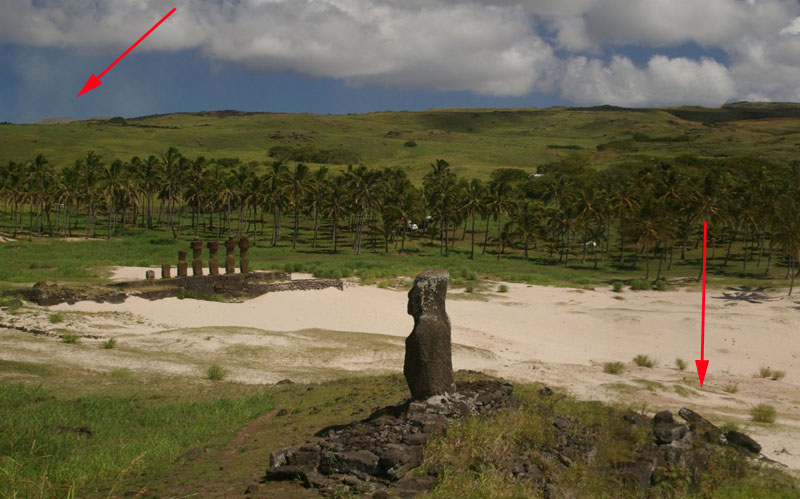
In this picture a solitary moai stands centrally and
looks towards the ahu platforms further inland. The arrow in the high left
hand side of the picture indicates the position of Puhi Mountain, the top
of which could be seen from this low level. From the top of Anakena Beach
hill, the coded distance to the mountain was 12441.6-feet at an azimuth angle
of 18.664-degrees return. The other arrow to the right of the picture points
to former marker positions that are now tumbled, but fully capable of divulging
their original codes of position.
We'll now identify the codes of distance and angle from the lone moai seen
above to the inland looking moai on Ahu Nau Nau:
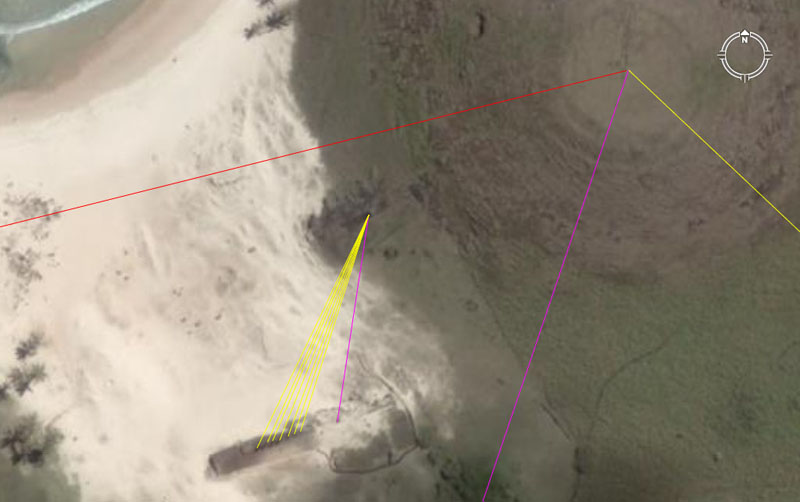
Again, we'll move from left to right along Ahu Nau Nau identifying the probable in-built codes of each moai in relation to the position of the lone moai marker further out.
1. 307.2-feet @ an azimuth angle of 25.6-degrees (moai to lone outer marker moai).
2. 295.3125-feet @ an azimuth angle of 24-degrees (moai to lone outer marker moai).
3. 291.6-feet @ an azimuth angle of 23.04-degrees (moai to lone outer marker moai).
4. 288-feet @ an azimuth angle of 21.6-degrees (moai to lone outer marker moai).
5. 280-feet @ an azimuth angle of 20-degrees (moai to lone outer marker moai).
6. 275-feet @ an azimuth angle of 18.75-degrees (moai to lone outer marker moai).
7. 270-feet @ an azimuth angle of 17.5-degrees (moai to lone outer marker moai).
The magenta line runs to a marker on a separate ahu platform. The coded distance to this large oval stone marker was 248.832-feet @ an azimuth angle of 8.64-degrees. These two codes and all of the others listed above are dynamic and were highly important to early caucasoid European cousin nations living around the Mediterranean Basin and Continental Europe. Their knowledge of navigation allowed them to roam the entire world at will thousands of years ago and set up many outlying civilisations, mining colonies or great schools like this one at Easter Island.
The markers represented mnemonic devices for other near proximity codes used in navigation or in reading the calendar related cycles, etc. Some measurements and angle readings could go to either side of the moai or to specific marks incised. Students would be expected to know all of the "close-proximity" codes and how to manipulate them in various kinds of navigational and astronomical calculations. At places like Avebury Henge in Southern England the large outer marker obelisks were even "drilled" sometimes to achieve a specific point of resolution on and within the stone. This same modus operandi is also in evidence on some moai of Easter Island, where a drilled hole indicates the refined point of terminating resolution for a surveyor's distance and angle vector.
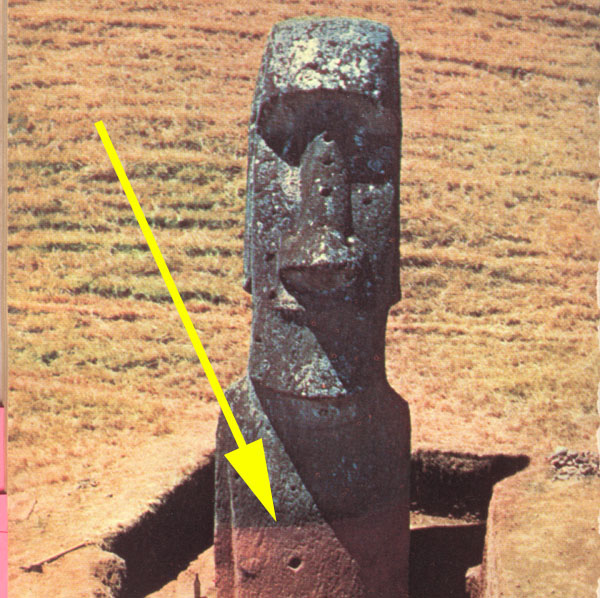
Like at Avebury Henge in Southern England, holes have been drilled in some monuments to give refined resolution points for surveyors. This same moai appears to have other marks drilled into the nose-bridge section. Although stone that was formed by the cooling of molten lava can have gas bubble holes showing through to the surface, these holes in the moai don't appear to have occurred in that natural way, but look more like drilled marks to indicate termination points for surveying lines coming in from several frontal directions.
Let's now move to the "12 o'clock" position on the island and circle around the coastline clockwise, ahu platform by ahu platform. This incentive will take months to complete, but we'll make a start and add the rest as time goes by.